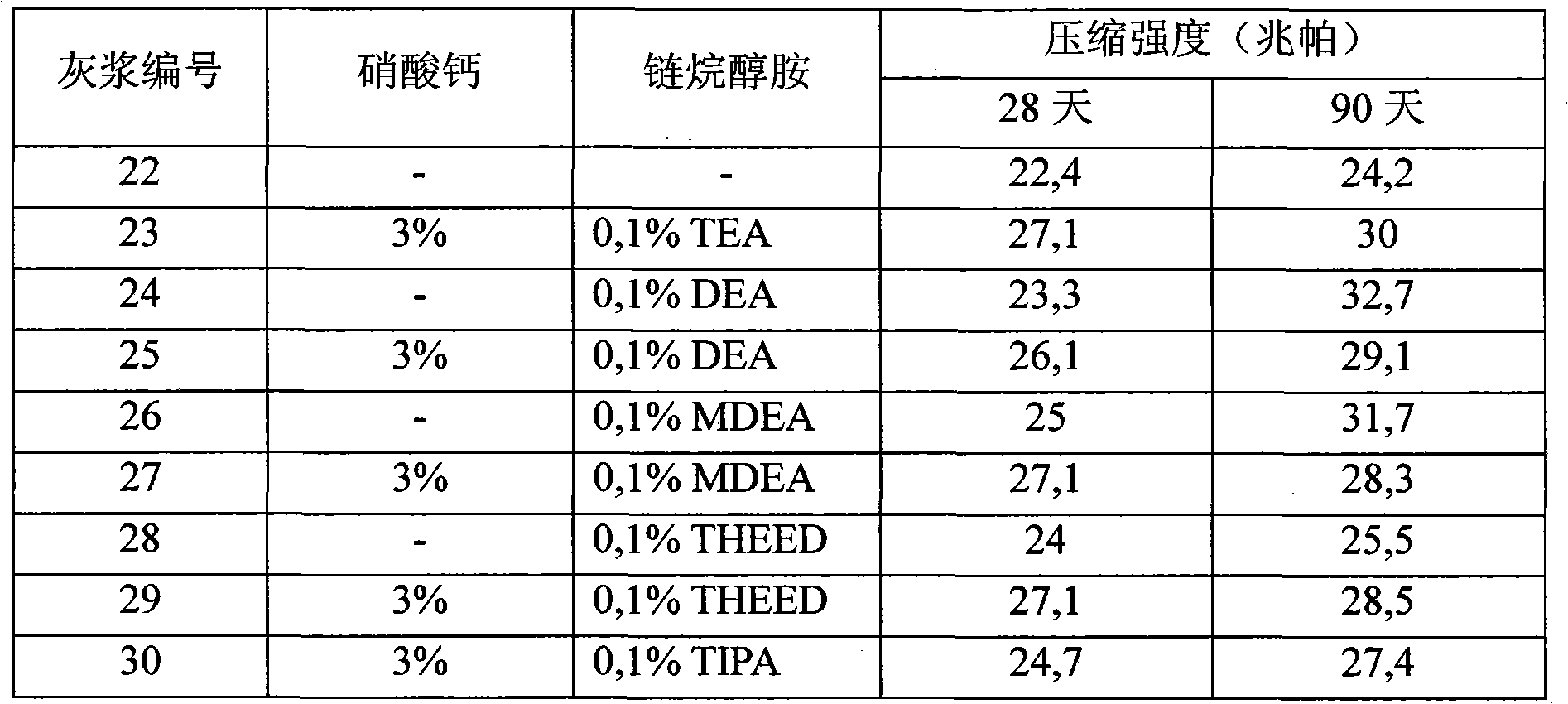Additives for cement
A cement composition and calcium sulfoaluminate technology are applied in the field of additives for dicalcium silicate-calcium sulfoaluminate-ferrite cement, and can solve the problems of not being able to obtain modern concrete properties, not being able to provide short-term strength, etc.
- Summary
- Abstract
- Description
- Claims
- Application Information
AI Technical Summary
Problems solved by technology
Method used
Image
Examples
Embodiment 1
[0115] Standard mortars are produced according to EN 196 using the following components:
[0116] BCSAF cement (batch 1) 450g
[0117] water 225g
[0118] Standard sand 1350 grams
[0119] BCSAF cement was prepared as described in Example 6 for clinker 2 in Table 7 of US-A-20070266903.
[0120] Alkanolamines (triethanolamine (TEA) or triisopropanolamine (TIPA)) and / or calcium nitrite were included in the mortar samples at the levels indicated in Table 1 below to prepare Mortars 1 to 12. The content of calcium salts is expressed in % dry weight / cement. The content of alkanolamine is expressed in % / mass of cement.
[0121] The compressive strength of the resulting mortar was measured on cylindrical test pieces of 4 x 4 x 16 cm3 prepared using metal molds at 20°C. The samples were stored in water at 20°C for 7 or 28 days until the compressive strength was measured.
[0122] The results obtained are shown in Table 1.
[0123] Table 1
[0124]
[0125] TEA or TIPA alone ...
Embodiment 2
[0130] Standard EN 196 mortars are manufactured using the following components:
[0131] BCSAF cement (batch 1): 315 grams
[0132] Limestone filler: 135g
[0133] Water : 225g
[0134] Sand: 1350g
[0135] (Note: For the purposes of EN 196 mortar formulations, the limestone filler is considered to be part of the cement so that the total cement content is still 450 g)
[0136] Alkanolamine, triethanolamine (TEA) or triisopropanolamine (TIPA) and / or calcium nitrite or calcium nitrate were contained in the mortar samples at the contents shown in Table 2 below, thereby preparing mortars 13 to 21. The content of calcium salt is expressed in % dry weight / (cement+filler). The content of alkanolamine is expressed in % / mass of cement+filler.
[0137] The compressive strength of the prepared mortar was measured using the procedure described in Example 1.
[0138] The results obtained are shown in Table 2.
[0139] Table 2
[0140]
[0141] The dosage of calcium nitrate in mo...
Embodiment 3
[0148] Standard mortars are produced according to EN 196 using the following components:
[0149] BCSAF cement (batch 2): 337,5 g
[0150] Limestone filler : 112,5 g
[0151] Water : 225g
[0152] Sand: 1350g
[0153] (Note: For the purposes of EN 196 mortar formulations, the limestone filler is considered to be part of the cement so that the total cement content is still 450 g)
[0154] Alkanolamines, with or without calcium nitrite or calcium nitrate, were included in the mortar samples at levels indicated in Table 3 below to prepare mortars 22 to 30. The content of calcium salt is expressed in % dry weight / (cement+filler). The content of alkanolamine is expressed in % / mass of cement+filler.
[0155] The compressive strength of the prepared mortar was measured using the procedure described in Example 1. The results obtained are shown in Table 3.
[0156] table 3
[0157]
[0158] In the absence of calcium nitrate, MDEA provided a maximum strength increase of 28 da...
PUM
 Login to View More
Login to View More Abstract
Description
Claims
Application Information
 Login to View More
Login to View More - R&D Engineer
- R&D Manager
- IP Professional
- Industry Leading Data Capabilities
- Powerful AI technology
- Patent DNA Extraction
Browse by: Latest US Patents, China's latest patents, Technical Efficacy Thesaurus, Application Domain, Technology Topic, Popular Technical Reports.
© 2024 PatSnap. All rights reserved.Legal|Privacy policy|Modern Slavery Act Transparency Statement|Sitemap|About US| Contact US: help@patsnap.com










